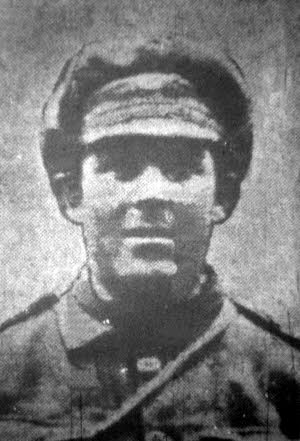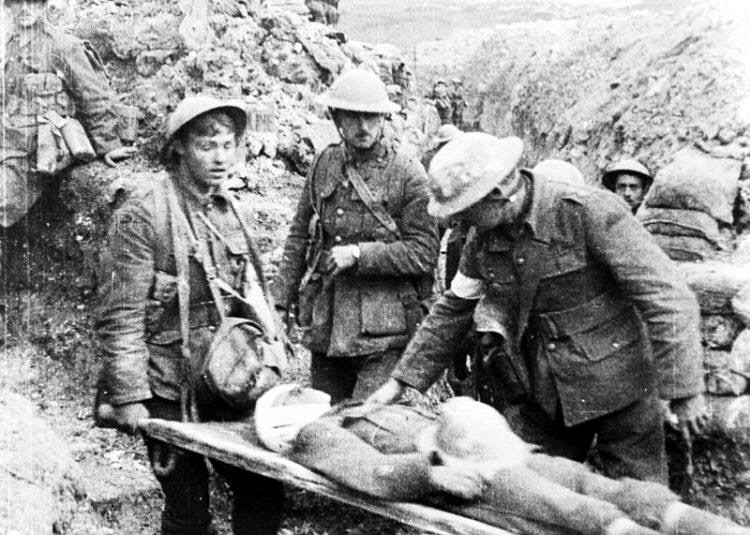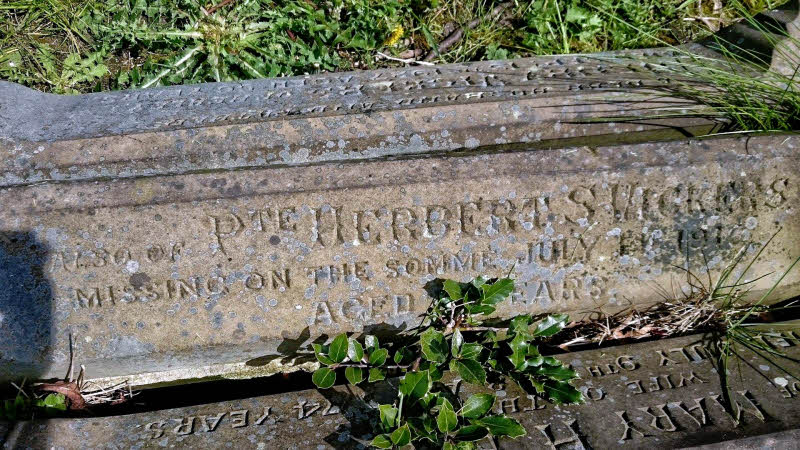
Herbert Smith Vickers was born in Ossett on the 1st April 1894, the first child of Ossett-born Henry Vickers and Middlestown-born Mary Hannah (nee Beaumont) who married at South Ossett Christ Church on the 14th October 1893. Herbert was baptised at the same church on the 6th May 1894.
In 1901 and 1911 the family of four, including a ten month-old girl, Alice, were living at 43, Kings Buildings, Healey, Ossett and Henry Vickers was working as a foreman warehouseman. By 1911, Herbert, now aged 17 had found work as a cardroom jobber in a local mungo mill.
10th (Service) Battalion, KOYLI was formed at Pontefract in September 1914 as part of K3 and came under command of 64th Brigade in 21st Division. The Battalion moved to Berkhamsted and then to Halton Park (Tring) in October 1914, going on to billets in Maidenhead in November. They returned to Halton Park in April 1915 and went on to Witley in August. In September 1915, they landed in France. on the 13th February 1918 the battalion was disbanded in France, with at least some of the men going to 20th Entrenching Battalion.
Herbert’s army service record has not survived but his MIC reveals that he embarked for France on the 11th September 1915 and he was awarded the 1914-15 Star in addition to the British and Victory medals.
The 10th KOYLI were involved in the attack on Fricourt on the opening day of the Battle of the Somme on the 1st July 1916 as part of 64 Brigade, 21st Division. The 64th (Northern Brigade) in 21 Division consisted of the 9th and 10th Kings Own Yorkshire Light Infantry (KOYLI) in the front line, with the 15th Battalion Durham Light Infantry (DLI) and the 1st Battalion East Yorkshire Regiment in reserve.
The 10th Battalion, KOYLI war diary for the 1st July 1916 is very brief:
“The British offensive commenced, this battalion leading the 64th Brigade assault. They left the trenches at 7.30 a.m. and took Crucifix Trench that morning and held it till early the next day, when they were relieved by the 1st Lincolns. Casualties – Officers Killed: Capt. C.R. Heygate, Lt. J.W. Bamber, Lt. R.S.M. Beatson, 2nd Lt. J. Andrew, 2nd Lt. K.J.P. Asher, 2nd Lt. A.C. Cockroft, 2nd Lt. J.A.A. Fountain, 2nd Lt. M.E.J. Maude, 2nd Lt. L.F. Sharp, 2nd Lt. G.F.N. Wilkinson. Wounded 16, Other Ranks Killed 50, Wounded 292, Missing 135.” Those missing including Private Herbert Vickers.
Prior to Zero Hour (0730) the men from the KOYLI battalions (9th and 10th) crawled out into no man’s land in readiness for their assault. In front of them the German wire had been well cut by the week long artillery bombardment and both battalions made swift progress through the German’s front line trenches. Within 30 minutes they had secured an area around the north of Fricourt village as far as the road to Contalmaison. Here they were held by machine gun fire coming from their front and flanks, and dug in. To their left the 34th Division’s attempt at taking La Boisselle had been repulsed with enormous loss to its Tyneside Brigades. As the 34th Division attempted to remedy the situation the KOYLI found themselves in the unenviable situation of maintaining a position surrounded on three sides.
The “Ossett Observer” 1 had this obituary for Herbert Vickers:
“Private Herbert S. Vickers (22), of the King’s Own Yorkshire Light Infantry, son of Mr. and Mrs. H. Vickers of 43, Healey Road, Ossett, has officially been posted as missing since the “big push” in July last year, and on Saturday his parents received a War Office notice stating that now the authorities were sorry to have to conclude that he was dead. Private Vickers, who was well-known in the district as a football player, having played with Healey Celtic, Thornhill Edge and South Ossett Church Institute. He was employed at Messrs. Fawcett and Firth’s mill at Healey, when he enlisted in September 1914. Just a year later he went to the battlefield and took part in the first extensive operations at Loos.“

Above: Wounded soldier at the Battle of the Somme, 1st July 1916.
Private Herbert Vickers died on the opening day of the Battle of the Somme, on the 1st July 1916, aged 22 years. His body was never found and he is remembered on Pier and Face 11C and 12A of the Thiepval Memorial, 2 Somme, France. The Thiepval Memorial can be found on the D73, next to the village of Thiepval, off the main Bapaume to Albert road (D929).
On 1 July 1916, supported by a French attack to the south, thirteen divisions of Commonwealth forces launched an offensive on a line from north of Gommecourt to Maricourt. Despite a preliminary bombardment lasting seven days, the German defences were barely touched and the attack met unexpectedly fierce resistance. Losses were catastrophic and with only minimal advances on the southern flank, the initial attack was a failure. In the following weeks, huge resources of manpower and equipment were deployed in an attempt to exploit the modest successes of the first day. However, the German Army resisted tenaciously and repeated attacks and counter attacks meant a major battle for every village, copse and farmhouse gained. At the end of September, Thiepval was finally captured. The village had been an original objective of 1 July. Attacks north and east continued throughout October and into November in increasingly difficult weather conditions. The Battle of the Somme finally ended on 18 November with the onset of winter.
In the spring of 1917, the German forces fell back to their newly prepared defences, the Hindenburg Line, and there were no further significant engagements in the Somme sector until the Germans mounted their major offensive in March 1918.
The Thiepval Memorial, the Memorial to the Missing of the Somme, bears the names of more than 72,000 officers and men of the United Kingdom and South African forces who died in the Somme sector before 20 March 1918 and have no known grave. Over 90% of those commemorated died between July and November 1916. The memorial also serves as an Anglo-French Battle Memorial in recognition of the joint nature of the 1916 offensive and a small cemetery containing equal numbers of Commonwealth and French graves lies at the foot of the memorial.

Above: The Vickers family commissioned this memorial stone for their missing son, Private Herbert S. Vickers at the Manor Road Cemetery in South Ossett when it was known that he wasn’t ever coming home. May 2016
References:
1. “Ossett Observer”, February 10th 1917